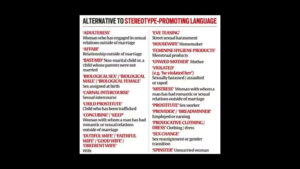Table of Contents
Introduction
The Chief Justice of India (CJI) has released a Handbook, correcting Gender Stereotypes and offering guidance on how to avoid utilizing harmful gender stereotypes, in particular those about women, in judicial decision-making and writing.
What is the Handbook on Gender Stereotypes?
The Handbook on Gender Stereotypes is released by the Supreme Court of India to assist judges and legal practitioners in recognizing, understanding, and combating gender stereotypes in legal language and judgments. It highlights common stereotypical words and phrases that are often used to describe women in legal documents.
It points out instances where such language perpetuates antiquated or incorrect notions about women’s roles and behavior. It also provides specific examples of language that should be replaced with more neutral and accurate terms.
For instance, it suggests using “woman” instead of “career woman,” “street sexual harassment” instead of “eve teasing,” and “rape” instead of “forcible rape.”
Suggested Language in Supreme Court’s Handbook
| Stereotype-promoting language (Incorrect) | Stereotype-promoting language (Incorrect) |
| Affair | Relationship outside of marriage |
| Concubine / keep | Woman with whom a man has had romantic or sexual relations outside of marriage |
| Chaste woman | Woman |
| Child prostitute | Child who has been trafficked |
| Eve teasing | Street sexual harassment |
| Forcible rape | Rape |
| Hooker/Prostitute | Sex worker |
| Ladylike | Use a gender-neutral description of behaviour or characteristics (e.g., amusing or assertive) |
| Marriageable age | A woman who has attained the legal age required to marry |
| Mistress | Woman with whom a man has had romantic or sexual relations outside of marriage |
| Unwed Mother | Mother |
| Woman of loose morals / easy virtue / promiscuous woman / wanton woman/ whore | Woman |
| Violated (e.g., he violated her) | Sexually harassed/assaulted or raped |
| Provocative clothing / dress | Sexually harassed/assaulted or raped |
| Ravished (e.g., she was “ravished” by him) | Use a gender-neutral description of behavior or characteristics (e.g., amusing or assertive) |
Survivor or Victim? An individual who has been affected by sexual violence may identify themselves as either a “survivor” or “victim”. Both terms are applicable unless the individual has expressed a preference, in which case the individual’s preference should be respected

Objective
- The handbook aims to promote more equitable and unbiased language usage in judicial discourse.
- The goal of the handbook is to encourage a shift towards language that reflects a more modern and respectful understanding of gender and promotes equal rights for all individuals, regardless of their gender.
What is Gender Stereotyping?
Gender stereotyping refers to the practice of assigning specific attributes, characteristics, or roles to individuals based solely on their gender. These stereotypes can be pervasive in societies and can impact how people perceive and treat each other based on their gender. For example, women are supposed to be nurturing and avoid dominance, and men are supposed to be agentic and avoid weakness


Impacts of Gender Stereotyping on Women
Gender stereotypes act as a barrier for girls to access quality education. For example, stereotypes about the role of women as confined to the domestic and family sphere underpin all obstacles to girls’ equal access to quality education.
Women are often held back from high-status positions in society.
The persistent gender gap in education, employment, and wages is due in part to gender stereotyping.
Harmful gender stereotypes, rigid constructions of femininity and masculinity, and stereotyped gender roles are the root causes of gender-based violence against women.
Insight on Handbook
The Supreme Court’s handbook on Combating Gender Stereotypes defines stereotypes as “a set idea that people have about what someone or something is like especially an idea that is wrong”, which gives a glimpse of how stereotypes function, and their impact on judicial decision-making. It categorizes the different types of gender stereotypes as Stereotypes based on the so-called ‘inherent characteristics’ of women; Stereotypes based on gender roles; and Stereotypes concerning sex and sexual violence
FAQ
Handbook
The SC has created the handbook to assist lawyers and judges in making conscious choices while drafting pleadings and not unwittingly employing stereotypes. It also highlights judgments that have rejected stereotypes.
Why is it Important for Judges to Use the Right Words?
- The handbook argues that the language a judge uses reflects not only their interpretation of the law, but their perception of society as well.
- Even when the use of stereotypes does not alter the outcome of a case, stereotypical language may reinforce ideas contrary to our constitutional ethos.
- Language is critical to the life of the law. Words are the vehicle through which the values of the law are communicated.
- Words transmit the ultimate intention of the lawmaker or the judge to the nation.
